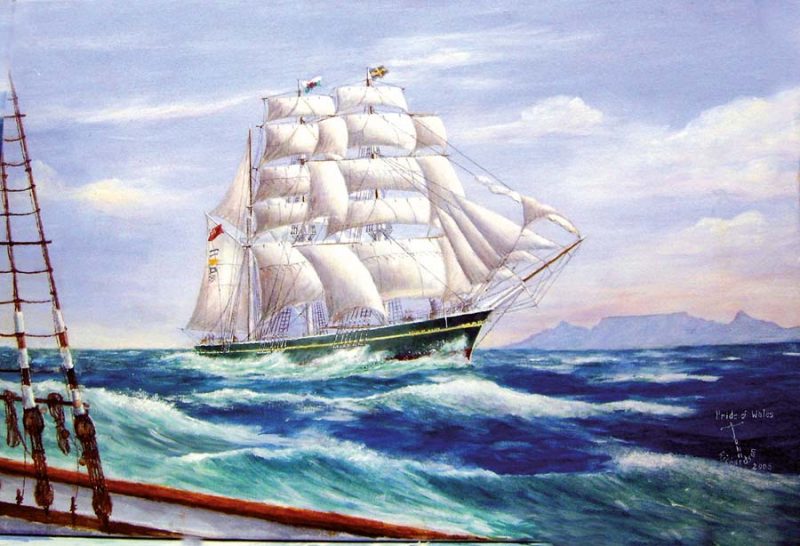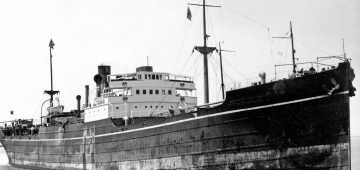When the wooden built three masted barque ‘Pride of Wales’ came off the stocks at Borth y Gest in 1868, she really did make an impact in the north Wales shipping fraternity, because with a gross register of 298 tons and the ability to carry 500 tons of cargo, it made her by far the largest vessel that was ever built in the area, with the normal size of the many slate carriers being around the 100 gross ton mark.

The barque had been designed by Simon Jones for Captain David Morris who was going to be her owner captain. The ship’s waterline length was 125 feet while her overall length which included the bowsprit and jib-boom gave her an extra 40 feet, her beam was 26.5 feet while the depth of hold was 14.5 feet and her international signal code was JQPN. The beautiful figurehead on her stem was a carving of Miss Jenny Morris the captain’s seventeen-year-old daughter, and the girl who’d performed the launching to the cheering crowd. Painted with a bottle green ship’s side and a band of gold around the hull at deck level, she had the usual scroll work on the bow. Once completed she loaded 500 tons of slate and general cargo at Porthmadog for her first trip to India with a crew of twelve, where she’d been chartered for seven years by the Indian government. But when carrying a full cargo the Pride of Wales was a very ‘wet ship’ in heavy weather, and all due to her low freeboard which was a mere three feet at the waist. When the Pride of Wales began on her charter running between Rangoon and Chittagong, the sailors who’d brought her out to India were paid off and replaced by Indians. That move enabled Captain Morris to pay his new crew a fraction of what he would have had to pay his Porthmadog sailors. The only three who completed the seven-year voyage on the Indian coast were the captain, the 1st mate, and John Hughes the carpenter cum bosun. But the Indian sailors were seldom up to scratch and were replaced at frequent intervals by the hard case Porthmadog 1st mate who stood no nonsense and ruled with an iron fist. However, after seven years of trading around the Indian coast, the Pride of Wales returned home to the UK after having paid for her building costs many times over. Captain Morris retired from the sea after that long trip having made more than enough money to retire at a relatively young age, while he still operated the slate carriers Ocean Monarch, Success, Excelsior and Royal Charter.

The Pride of Wales’ new commander was Captain Evan Pugh who stayed on the ship for ten years in the foreign going trade. Her next and last captain was John Griffiths who on many occasions loaded coal at Swansea and Cardiff as well as slate from Porthmadog for the four corners of the globe. In 1890 he took the little ship through a Lloyds reclassification survey at Porthmadog, where on being reduced to a barque it allowed the ship to dispense with two sailors. By that time in 1890 at the age of 22 she really did have that bedraggled look about her, with rust from her iron work showing through and an abundance of rot in her shipside timbers and oaken frames. Her next trip after her survey was with 500 tons of slate for Hamburg,
However, once at sea the alterations and renewals of her refit began showing through, and the troubled little barque had to put into Falmouth to effect repairs which in the main was the rigging. But after the masts had been unshipped and replaced with a rake on them the ship’s speed increased. After discharging at Hamburg the deck crowd were told that their next cargo was to be for Rio de Janeiro, whereupon they all downed tools and wanted off. Indeed, Rio was a port that was noted for its yellow fever outbreaks, and at that particular time there were a number of visiting ships which were anchored there crewless after their sailors had succumbed from the deadly disease. A new crowd of Scandinavians were signed on at Hamburg and the ship sailed for Rio where after avoiding any of the deadly diseases, the barque discharged and loaded cotton for the mills of Lancashire.
The next voyage for the Pride of Wales was a cargo of coal from Cardiff to Ascension Island for the coal burning ships of the Royal Navy. Sailing light ship from Ascension to Bridgetown in Barbados, she arrived there nineteen days later and loaded a cargo of 90,000 coconuts for London but she had to go to Mayaro Bay in Trinidad to load them. On the ships next voyage to Santos with Cardiff coal one of the sailors died of yellow fever. The ship loaded cotton and coffee at Santos and took it to London. On discharge she once again sailed to Santos in February 1892 on what was to be the 24 year old ship’s last voyage. On arrival it was found that the port city was being ravaged with yellow fever and smallpox. A score of crewless ships lay at anchor in the bay in what was the start of summer and when half a dozen of the Pride of Wales’ crew died.
The Pride of Wales lay there for four months before signing on a new crew. Captain Griffiths who was one of four survivors later stated, that he attended the funerals of 15 captains while his ship was laying anchored at Santos. However, with a new crowd of scratch replacement sailors the ship eventually sailed to Cayo in Mexico to load ore for the UK. But when abeam of Bermuda at Christmas she was hit by a terrific storm. Due to the poor quality sailors the sails were soon in shreds but the motley and inexperienced crew were helpless. The cargo of ore gave trouble in shifting after the ballast boxes had collapsed and two sailors were washed overboard and lost with the heavy rolling, her gear was strewn all over the decks and the Pride of Wales started going down by the head and began to sink. Fortunately the weather eased and a Norwegian ship of sail which was close by came to the rescue. After taking off Captain Griffiths and the remaining six of his crew, the Norsemen who were themselves short of food and water were compelled to take any vittles including drinking water from the stricken ship’s storeroom to feed the survivors.

The rescue operation took all day with just one lifeboat able to make the transfers of the stores and survivors, but at dusk the gallant little Welshman with its sails gone and her yards all askew, gave up and slipped beneath the grey waters of the North Atlantic.

Comments
Sorry, comments are closed for this item